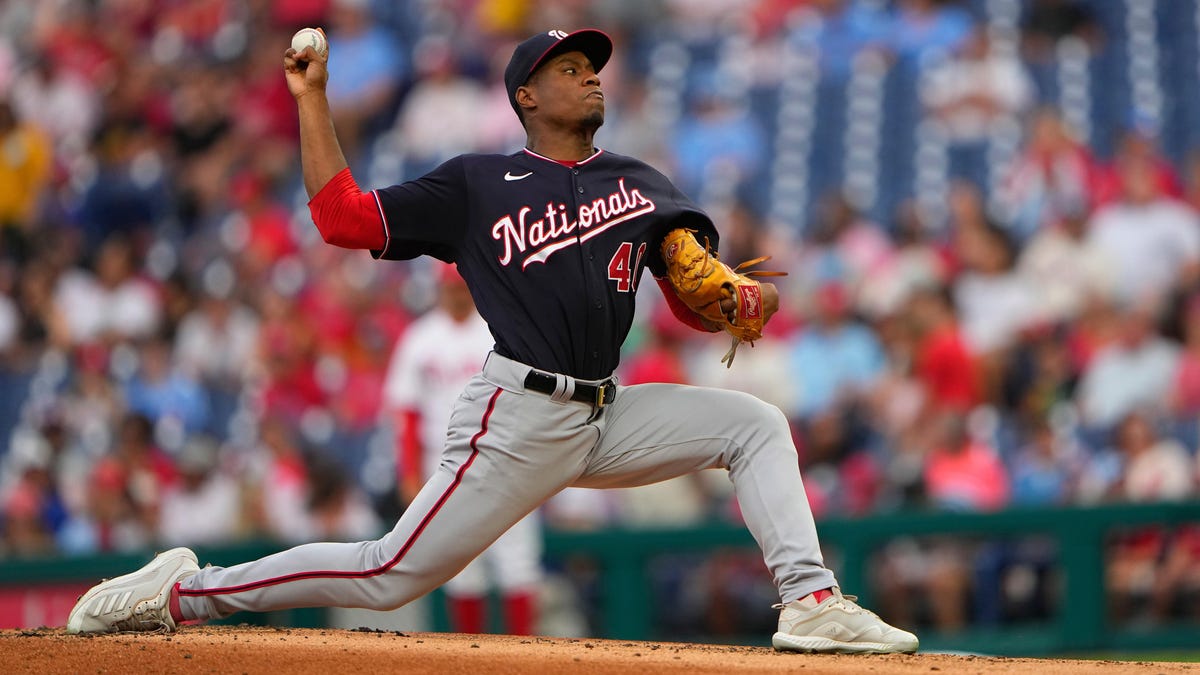Imagine if Josiah Gray develops an elite fastball

Coming into the 2022 season, Josiah Gray was Washington’s No. 3 prospect. He was a top-100 prospect throughout all of last season when he was dealt to the Nationals as part of the Trea Turner/Max Scherzer deal. In his limited time with the Dodgers and Nats last season, Gray showed flashes of excellence. His Baseball Savant page was filled with red in categories like weak contact percentage, expected batting average against, chase rate, and whiff percentage. Yet, with that many great figures in that many important categories, you’d expect Gray’s base stats to be a little better.
Gray’s rookie season was plagued by inconsistency. For every Aug. 7 at Atlanta came a Sept. 5 against the Mets. Gray, who posted a 5.48 ERA, clearly had some issues, especially in regards to limiting the long ball, and fans were hoping Gray could shore up those flaws in his sophomore season.
And he has, for the most part. While Gray’s fastball spin rate has regressed from last year, almost every other statistic has improved. Strikeout rate, hard-hit percentage, average exit velocity—all of them are trending upwards for Gray. But there are still some causes for concern. After his career-high 11-strikeout performance against the Phillies last night—marking his sixth start in his last seven outings going at least five and giving up two or fewer runs—analysts and fans alike were taking to the internet to talk about how outstanding and filthy Gray is.
His slider is absolutely devastating. It can make lefties buckle at the knees and make righties swat at flies a foot off the plate. However, his fastball needs to develop before he can push that 4.14 ERA and 4.94 FIP into the mid-3s. Gray’s fastball is the weakest of his four-pitch repertoire—fastball, changeup, slider, curve—but as is the case with every pitcher under the sun, he throws his fastball most often (43 percent of the time to be exact). While his velocity is lower than you’d like an ace’s to be—sitting at just a hair over 94 miles per hour—that’s not the issue. The issue is his spin rate.
G/O Media may get a commission

FREE
Audible Premium Plus 3-Month Free Trial
Listen up
The Audible Premium Plus experience for Amazon Prime users includes unlimited listening to the Premium Catalog, plus (see what they do there?) one credit per month for any title of their choice.
In 2022, Gray’s fastball averages 2,181 rotations per minute. That’s pretty average, and that lack of spin is likely a big reason why it’s been Gray’s least effective pitch. To put that in perspective, Yankee ace Gerrit Cole currently is averaging 2,455 rpm, 39-year-old Justin Verlander is sitting at 2,413, and even rookie MacKenzie Gore is averaging 2,233 rpm. Gray does a great job of putting backspin on the ball—he’s one of the best in MLB at it actually—but that backspin needs to be accompanied by velocity and spin rate to be effective against hitters. Gray has neither. When your fastball, the pitch most people rely on when they have to throw a strike, is your least effective pitch, that’s a bad situation to be in. And with Gray currently throwing only 58.8 percent first-pitch strikes—once again, pretty mediocre—he’s going to find himself behind in the count, reliant on that fastball, more often than he would probably like to.
Furthermore, Gray loves to live high in the zone with his fastball. That’s not a bad thing—if your fastball is effective. This is likely another large factor in Gray’s high home run rate. Of all pitchers with at least 50 innings pitched this season, Gray possesses the fifth-highest home runs allowed per nine innings at 1.9. Until Gray adds more spin to his fastball, he’s going to have to live lower in the zone and rely more on ground balls. I know that might hurt his strikeout numbers, but his fastball has never really been his putaway pitch. While Gray’s slider and curveball have maintained a 29.9 and 24.6 percent putaway percentage (percentage of two-strike pitches that result in a strikeout), his fastball holds just an 11.2 putaway percentage. Gray should continue using the high fastball in two-strike counts, but if he’s going to leave it high, he needs to make sure it’s out of the strike zone and near impossible for the hitter to take deep. He needs to set up his slider or curveball rather than rely on the high heat to force swings and misses, even heavier than he already is.
You don’t need to have a dominating four-seam fastball to have a long, successful MLB career. Look no further than Sergio Romo, who has played 15 years in the Majors now—for eight teams, no less—and pretty much only ever threw sliders and sinkers. However, most elite starters nowadays boast an impressive fastball that makes their offspeed filth all the more devastating. If Gray can develop that fastball just a tiny bit more, his slider and curveball could become the filthiest pitches in MLB, prone to several highlight reels on YouTube of hitters flailing at nothing. That’s when we’ll see Gray turn the corner and become the elite pitcher we all know he can be.
For all the latest Sports News Click Here

